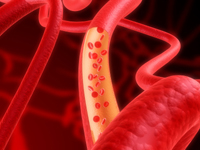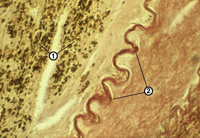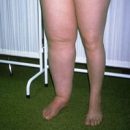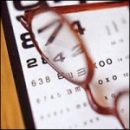Atherosclerosis aorta develops much earlier than other forms of atherosclerosis, but no symptoms are watched for a long time.The disease detects itself only to 60-70 years. We reveal the cunning disease...
Content
Atherosclerosis affects the walls of large arteries of our body. Aorta atherosclerosis is detected by the most common form of atherosclerosis and is detected from most patients with this disease. In atherosclerosis, various aortic sections may be affected, which in turn determines the symptoms and forecast of the disease. In this article we will consider various options atherosclerosis of the aorta of its symptoms and complications.
Journey through Aorte
 Aorta is the largest arterial vessel of our body. Aorta takes the beginning of the left ventricle of the heart, and then branches the many smaller vessels heading for all organs and tissues. Aorta consists of two departments passing in different anatomical areas of our body:
Aorta is the largest arterial vessel of our body. Aorta takes the beginning of the left ventricle of the heart, and then branches the many smaller vessels heading for all organs and tissues. Aorta consists of two departments passing in different anatomical areas of our body:
-
Breastway Aorta – The initial part of the aorta, from which arterys supplying blood supplying the upper half of the body (chest organs, head, neck, upper limbs).
-
Abdominal Aorta Department – The end portion of the aorta, from which the arteries supply the abdominal bodies supplying blood. The finite department of the abdominal aorta is divided into two branches (right and left iliac artery) for which blood is sent to the organs of a small pelvis and lower limbs.
What is aortic atherosclerosis
Aorta atherosclerosis is characterized by the formation of atherosclerotic plaques in the walls of aorta. Atherosclerosis of the aorta can capture the aorta on the entire length of its length or to affect individual sections of the vessel. Symptoms of atherosclerosis aorta depend on the localization of the disease and from the severity of changes in the aorta walls.
Symptoms and signs of atherosclerosis of the thoracic aorta
 Atherosclerosis of the thoracic aorta develops much earlier than other forms of atherosclerosis, but no symptoms are not manifested for a long time. Often atherosclerosis of the thoracic aorta develops simultaneously with the atherosclerosis of the coronary (coronary) arteries of the heart and atherosclerosis of the brain vessels.
Atherosclerosis of the thoracic aorta develops much earlier than other forms of atherosclerosis, but no symptoms are not manifested for a long time. Often atherosclerosis of the thoracic aorta develops simultaneously with the atherosclerosis of the coronary (coronary) arteries of the heart and atherosclerosis of the brain vessels.
The first symptoms of atherosclerosis Aorts appear aged 60-70, when the destruction of the walls of the aorta has already achieved significant scale. Patients complain about periodically emerging burning pain (Aortalgia), there is also an increase in systolic blood pressure, dizziness appear, difficulty of swallowing.
Other less specific features of atherosclerosis of the chest aorta can be too early aging and the appearance of gray hair, abundant hair growth in the ear sinks, the appearance of light stripes on the outer edge of the iris, the soverees on the skin of the face.
Symptoms and signs of atherosclerosis of the abdominal department of aorta
Atherosclerosis of the abdominal aorta is registered in more than half of all cases of atherosclerosis. As well as atherosclerosis of the breast, the aorta atherosclerosis of the Aorta may develop asymptomatic.
Symptoms Signs of an atherosclerosis of the abdominal aorta may be as follows:
-
Disorders of digestion: decrease in appetite, alternation of diarrhea and constipation, bloating;
-
Pain in stomach arise after meals and wear an attacking character. Usually, pains are not pronounced, buttering, without accurate localization. Pains independently pass 2-3 hours after occurrence;
-
Weight loss in atherosclerosis of the abdominal system of aorta is progressive and is a consequence of a persistent violation of the digestive process.
-
Arterial hypertension in this case develops due to violation of the blood supply to the kidneys and activation of the renin angiotensin-aldosterone system.
-
Renal insufficiency develops due to the gradual replacement of normal kidney tissues with a connecting tissue (gradual death of the kidney tissue due to lack of blood supply).
-
Visceral arteries thrombosis – This is a deadly complication of an atherosclerosis of the abdominal part of the aorta, requiring immediate medical care.
Thrombosis as a result of atherosclerosis
Thrombosis of the vessels supplying the intestine leads to the death of the intestinal loops and the development of massive inflammation of the abdominal and peritoneum organs (peritonitis). Symptoms of thrombosis of visceral vessels This: strong pains that do not pass under the action of painkillers or spasmolitics. The sharp deterioration in the general state of the patient is quickly joined. The emergence of such symptoms in patients with abdominal ischemic disease should be caused by urgent appeal to the doctor. Without providing medical care thrombosis of visceral arteries necessarily leads to peritonitis and death of the patient.









